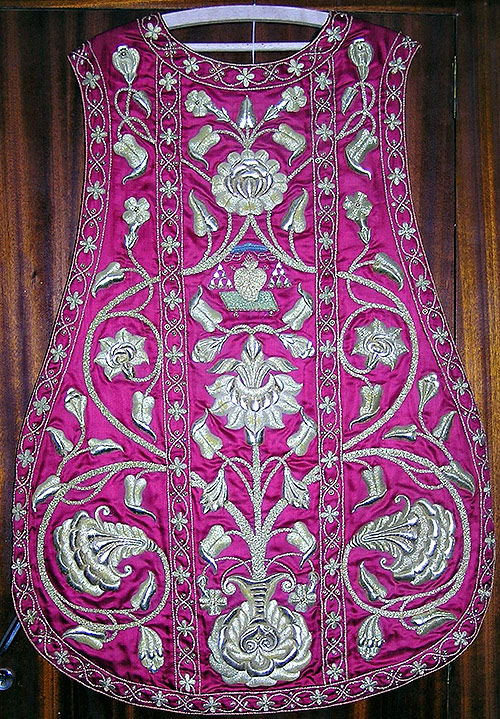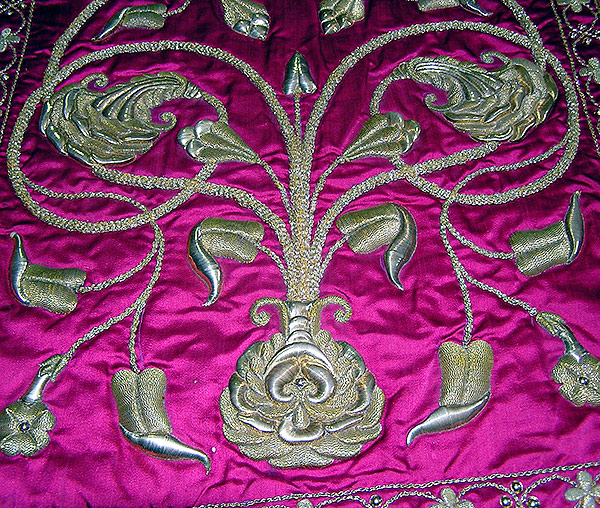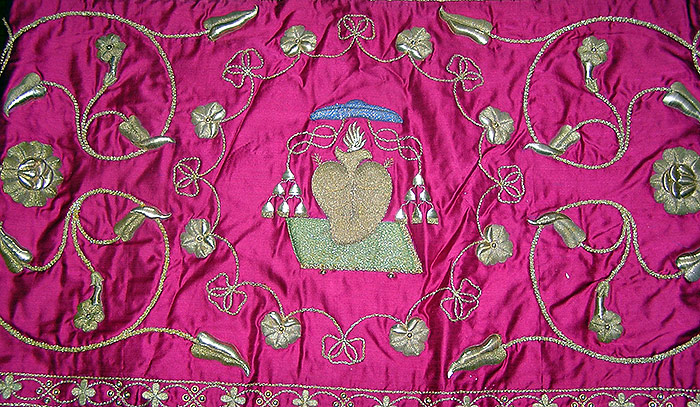The piece of the month of December 2023
CRIMSON PHILIPPINE TERN OF THE CONVENT OF THE AUGUSTINIAN RECOLLECTS OF MARCILLA
Alicia Andueza Pérez
Chair of Navarrese Heritage and Art
In 1865, the community of Augustinian Recollects settled in the convent of Marcilla, formerly a Cistercian monastery annexed to the Abbey of Oliva. Within its artistic ensemble, its collection of liturgical ornaments is important, mostly of Philippine origin, given the missionary relationship and the presence that the Augustinians had in this Pacific island.
The terno in question, one of the most outstanding in his repertoire, is made up of 18 pieces: a chasuble (94 x cm) with its stole and corresponding maniples, two dalmatics (86 x cm) with their respective maniples, stole and collars; a pluvial cloak (131 x cm), a lectern cloth (244 x cm), a shoulder cloth (47 x cm), a chalice veil (47 x cm), a corporal bag (23 x cm), a cross sleeve (54 x cm) and two candlestick sleeves (54 x cm).

Chasuble, dorsal view.
All the garments in this ensemble have a crimson satin background embroidered with gold thread. The decoration, based on large flowers and vegetal scrolls, expands throughout the field in a symmetrical and ascending manner, in a very dynamic curve-counter-curve movement. It also alternates with smaller leaves and flowers, while a border of rhythmic motifs skirts the ends and defines the traditional stripes of the vestments. In some of them, as in the chasuble in its dorsal part, the collars of the dalmatics, the hood of the pluvial cloak or the shoulder cloth, the ornamentation is completed with the Order's coat of arms, formed by a burning heart pierced by a dart on a book.
Technically, some of the embroidered motifs stand out for their high relief. These, configured with an important preparation in basto, are formed by alternating different procedures of plain gold and chopped gold. Plain gold, also called 'laid gold' and 'traversed gold', consists of covering the surface to be embroidered with a parallel series of metallic threads that are fastened to the canvas with small stitches of yellow or orange silk that are almost imperceptible. The horizontal or vertical placement of the gold threads and the arrangement of the silk stitches make it possible to achieve various designs and geometric patterns. On the other hand, in gold piqué, the thread alternately covers the front and back of the fabric, in this case with a raised edge. The alternation of the two techniques causes, together with the relief of the motifs, a combination of different textures and a large number of effects of brightness and light. This is accentuated, in some cases, with some gold studs and sequins.

Lectern cloth. Detail.
Regarding the linings of the garments, most of them have an orange taffeta fabric protecting the inside. In addition, both the embroidery and the base and protective fabrics are in a very good state of preservation, except for small areas in some of the garments where there are loose threads and part of the gold has been lost.
Chronologically, we can date this set to the second half of the 19th century and attribute its authorship to a Philippine workshop of the time, given its characteristics and the relationship of this religious order with the Asian country. Although there is no documentation in this regard, it can be assumed that this set arrived at the convent as a gift or donation from an Augustinian friar who developed his ecclesiastical degree program in the Philippines. In fact, it is documented in the sacristy book of file of the convent of Marcilla that, for example, Father Fernando Rubio (1814-1889), a native of Cintruénigo who resided in the Philippines since 1835, gave the image of Our Lady the White of Marcilla an embroidered mantle and a silver crown; and that Father Mariano Bernard (1838-1915), a native of Calanda (Teruel) who was in the missions of the Philippines, was President of Marcilla and occupied the position of general of the Augustinian order, also gave the same Marian image with another white mantle of flowers. It could well be that one of the above mentioned was the donor of such a sumptuous robe, which arrived at this convent together with another of the same characteristics but embroidered on white satin, which is in a worse state of preservation.

Shoulder cloth. Detail.
In addition to the data exposed, this set does appear in the different books of the sacristy inventories and thus we find, among the incarnated ornaments, a robe "embroidered in gold from the Philippines, containing the following: chasuble with stole and manipule, veil and chalice bag; two dalmatics with stole and manipules, both with their collars; lectern and shoulder cloth and three cuffs for processional cross and candlesticks, a pluvial cloak corresponding to this gold robe".
Likewise, although it does not appear in the inventories as one of the pieces of this ensemble, there is in the convent a cloak (176 x cm) and dress (89 x cm) of crimson satin of the White Virgin whose gold embroidered decoration is reminiscent of the different garments of the robe we are dealing with. In fact, although the background fabric is from the 20th century, the embroidery it carries is earlier. According to documentation preserved in the convent, we know that in 1950 the Augustinian Recollect Nuns of Pamplona made two cloaks, one of them red, extracting the embroidered decoration from other cloaks and pieces in the sacristy, which may indicate that originally this set also had a cloak for the Marian image of the convent.
To conclude, it is necessary to point out that this terno shares origin with other sets that, throughout the XVIII and XIX centuries, also arrived from the Philippines to several Navarrese temples, always by donation and gift. sample These include, for example, the Chinese-Philippine terno from the eighteenth century that is preserved in the parish of San Saturnino in Pamplona; the set of vestments that arrived at the parish of Arlegui by the hand of Don Joaquín de Arlegui, an ecclesiastic native of this town who held various posts in Manila; the chasubles from the end of the 18th century that are treasured in the church of Santa María de Viana; or one of the main mantles that make up the rich trousseau of the Virgin of the Tabernacle of the cathedral of Pamplona. These examples show embroidery in brightly colored silks, motifs that we usually associate more clearly with Philippine work. But, nevertheless, we also have other samples in Navarre of garments of this origin with gold embroidery, such as the terno known as de las Indias which is conserved in the cathedral of Tudela and which was a gift of Don Pedro de Galarraga y Castillo, an absent Tudela resident in Manila; or the mantle of the Virgen de la Paz of Cintruénigo, with gold embroidery in great relief dated 1870, which also came from the Augustinian Recollects.
SOURCES AND BIBLIOGRAPHY
file of the Convent of the Augustinian Recollects of Marcilla: Book Inventory of the Sacristy of the high school of Marcilla (1865-1955) and Book of Notarial Things of the Convent of Marcilla (1917-1982). We are grateful to Father Pablo Panedas for the documentary data .
ANDUEZA PÉREZ, A., El arte al servicio del esplendor de la liturgia: El bordado y los ornamentos sagrados en Navarra. Siglos XVI-XVIII, Pamplona, Gobierno de Navarra, 2017.
